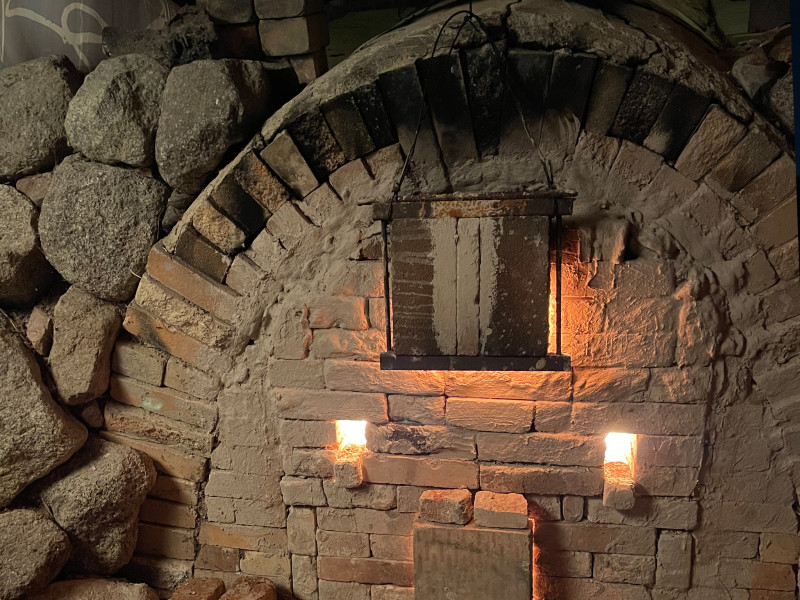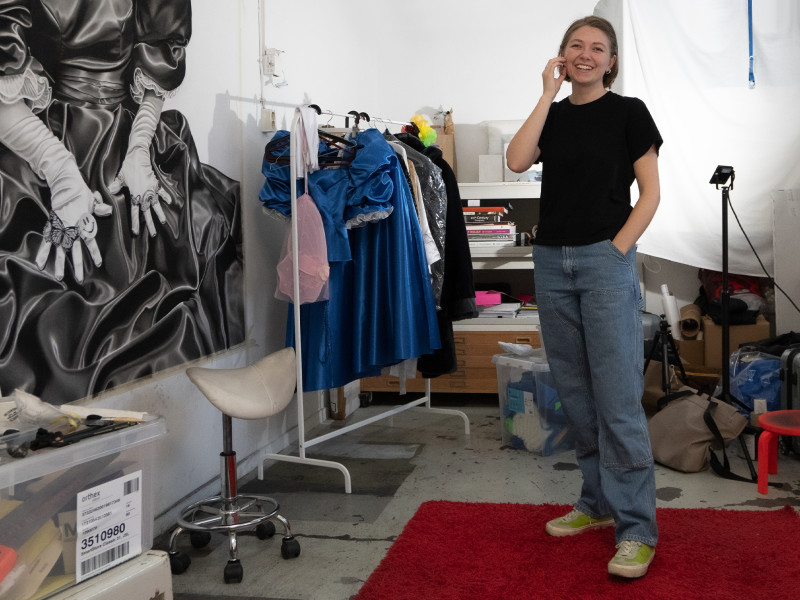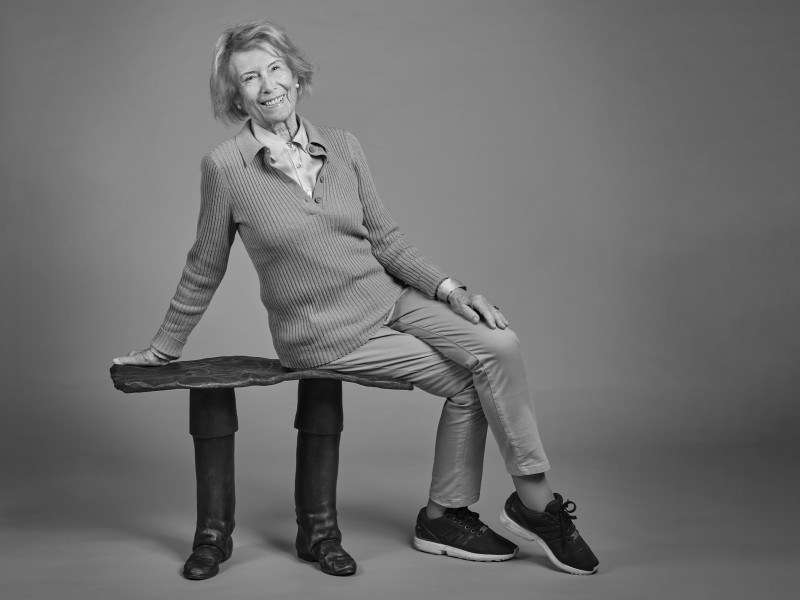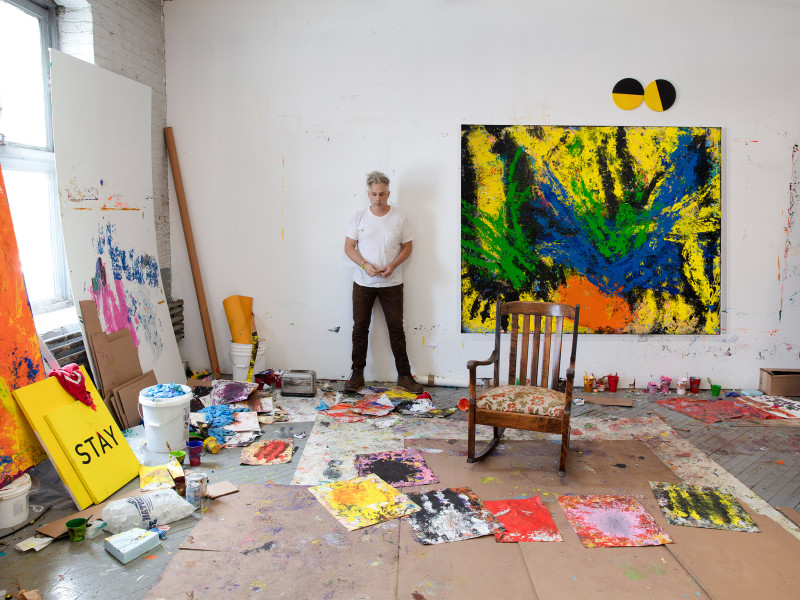Adam Ytterberg Interview by My Larsdotter
Interview
January 6, 2024
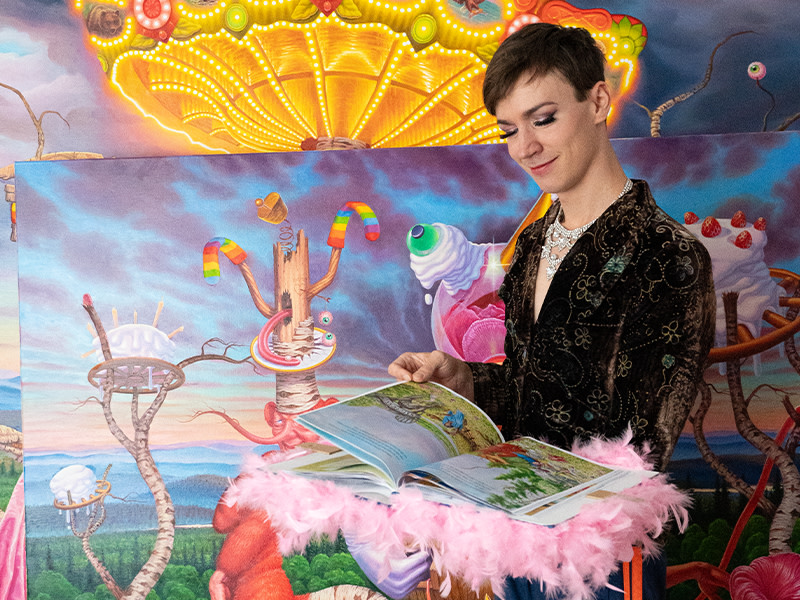
We met with Adam in his studio to have a chat about his new artworks and the upcoming exhibition Torun och Farmor uppe vid Myhrbodarna. Here’s what he had to say.
Welcome back to CFHILL, what have you been up to in the past year?
— Thanks! Wow, that’s a hard question. The year has flown past, so I haven’t really been able to sit down and reflect on what I have actually been doing. I have, of course, been writing, drawing, and painting for my new stories and this upcoming exhibition. I graduated Konstfack in June this year, and shortly after I moved from my studio at school to this new studio. I also moved out of my student apartment, so it’s been a lot of moving and planning as well as keeping track of everyday life. It was a busy time, but now that I’ve settled a bit, I’ve had the time to paint and go to various inspiring exhibitions. I have also really tried to just have some time off.
Is it hard to give yourself time off? “When you love what you do…”
— Yes, it can be easy to work too much. Sometimes you just feel so lucky to be working with your biggest interest, that you forget it’s actually a job. I suppose it’s both good and bad, and works differently for different people. It can be hard to balance, but I find it easier now that I’ve settled into this studio and realized that routines are really good for me in my life, to maintain the creative joy.
How has moving studios impacted your work?
— I think it has actually allowed me to let myself go a little more crazy when I paint. I think it’s because I can really get into it for long periods at a time. It’s great, but I’m also afraid it shows that I’m alone in here too much. I might need more people to visit and keep me on track so I don’t spiral too much. I have also had short periods where I lack motivation which I’ve never experienced before, but I think it might be because I’m not used to always being alone. In school there were always other people around and the context you were in helped to keep your spirits up. Now I have to do that alone, which takes some getting used to. All in all, I like it though. Having my own space that I enjoy being in has really given my creative work a lift.
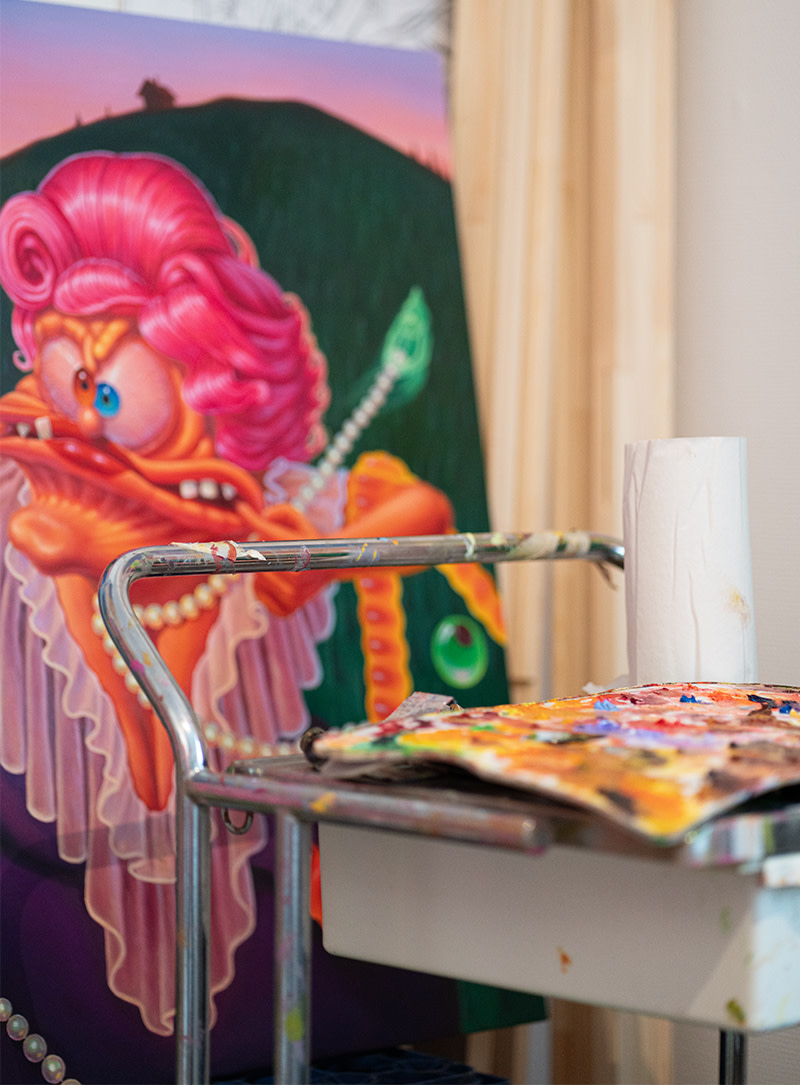
Let’s talk about your background; did you always know you
wanted to paint?
— I have always painted. Or at least since my early teen years. I started off doing a lot of pencil drawings, especially Donald Duck. After a while I switched the pencil out for acrylic paint, but the motifes were still the same. I actually can’t remember when or why I then moved to oil painting, but it was still in my teen years, and I still use it today.
Why do you paint with oil, what do you like about it?
— I like that it dries really slowly! I’m an easily stressed person, and an extreme time pessimist, so when I work, I don’t really have a timeframe. The slow drying process grants me enough time to go in and do the small changes and fixes that I want, without having to stress. Some people think that acrylic paint is the best medium for when you want to be able to change what you’ve done, but I think that more applies to the fact that it’s easy to cover the “mistake” and start over. For me, oil paint allows for editing in the motifes as you go, using the paint that’s already on the canvas.
Where do you get your inspiration from?
— I write my own stories, and those stories are in turn , are what my paintings are based on. My stories, or sagas, get inspiration from a lot of different things. They usually follow a theme, and some characters are recurring in most of them. They are often based in physical places and settings where the characters need to make things right after, for example, a catastrophe, but there’s also parallel stories that are more autobio- graphical. Those are based on my life and my experiences of being gay, so it’s also a lot about identity and seeking an identity. The ideas just come from within me. I think it’s a need that I have, to express myself, and the sagas have been a perfect outlet for that. In the end, the paintings themselves are like their own little worlds and sagas.
Tell us more about your alter-ego, who is a big part of your
work and process.
— Oh yes, my alter-ego is Greta Kris. If you had asked her, she would be disappointed that she wasn’t the very first subject we talked about and introduced. She is a very special character, and she emerged when the need to tell my stories for an audience arose. The stories have always been there, but suddenly people were demanding to
hear the stories as well as see the paintings. At first, I was actually quite mad that people wanted that, and thought: “Why isn’t my paintings enough?”. The stories are a part of my process and they’ve also always been rather personal and almost holy to me. I just didn’t think the audience needed to see my whole process, because it was mine. After a while though, I saw it from another perspective instead, and thought: “Well, why wouldn’t I share this part with them as well?”. The only problem was how I was going to do it, and that’s how story time with Greta Kris came to be. It felt good to tell them out loud, but as someone other than myself.
So, who is Greta Kris, where does she come from?
— At first I thought she came from the world that’s part of my stories, Torun & Farmors world, but then I realized she’s rather a bridge between that world and our world, and that she comes from both of them. When she’s here and we get to see her, it’s so that she can read the stories out loud to those who want to listen.
In the upcoming show there’s a large variety in formats, from the very tiny to very large format, what’s the difference when working in various sizes?
— Historically, I have almost only painted small paintings. I’m not really sure why they’ve recently gotten bigger, but it might just be that I feel that the motives need the space of a bigger canvas to achieve their true potential. In retrospect, I think the small format was some sort of security for me, something that I’ve always done.
Now though, I think painting in a smaller format is actually more challenging. Of course, I have a limit in how big I can go, for now, but you never know in the future. Changing formats can be a way to maintain the interest and challenge myself!
What is your relation to colours, how do you work and relate to them?
— I’ve always enjoyed colours and colourful motives, and I think it springs from my interest in cartoons from when I was little. I read and watched a lot of Donald Duck and other cartoons. One day there was a Tom & Jerry marathon on Cartoon Network, and I remember how I just sat still and watched the entire thing the whole day, until I got a headache, and then I continued watching it with a headache. I’ve always been fascinated by color, and the playfulness it inspires and conveys. I find that a key to achieving a colorful painting is to work with layers. I usually start off with a foundation in ochre and then I build with layers on layers. That also gives me the ability to work with contrasts in the motive and color, which in the end can give that light and almost neon look, without using neon. That’s also a part of why I love oil paint, because it’s usually very strong in pigment, which helps me in my work.
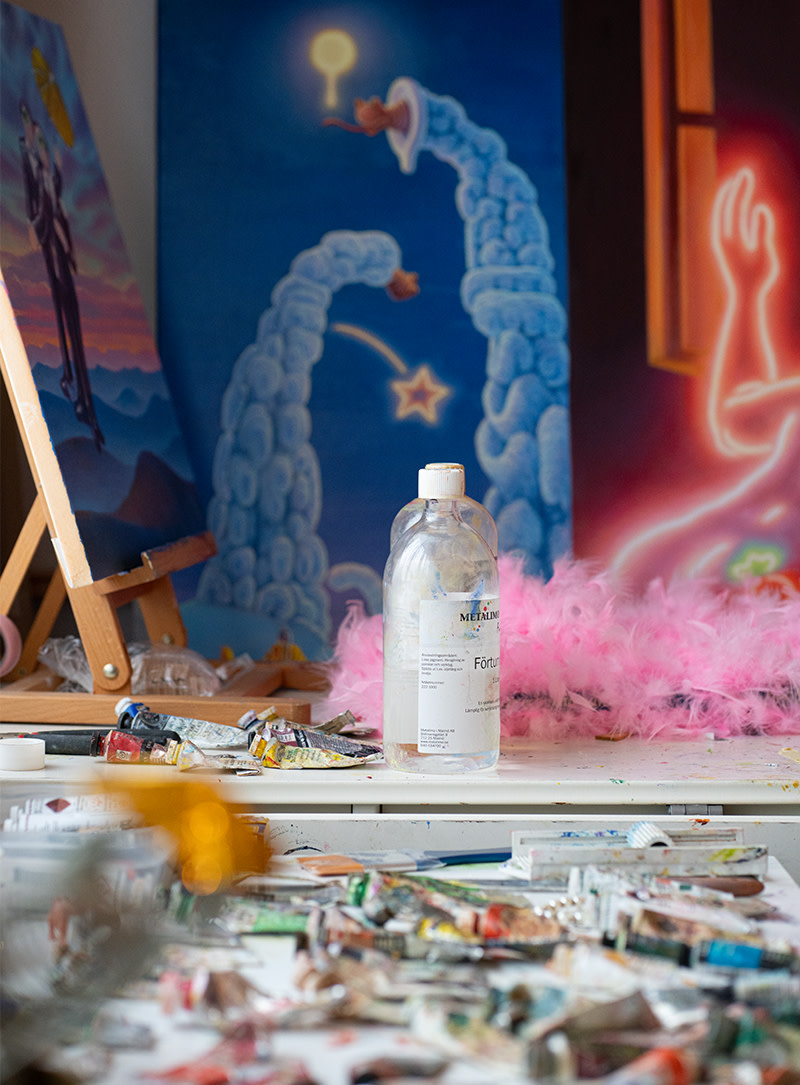
There’s often a lot of information in the motives of your works, especially in the small details; do you have a final picture in your head on how you want it to turn out, or does it develop as you go?
— I always start with thinking what part of the story I want the painting to show and portrait, and then use that to start sketching on paper. Usually, I end up with a few different sketches, and then I merge them together in the end. When I’m happy with those, I decide the format and sketch the motive on canvas. Sometimes when the format changes, I’m not happy with the motive and have to change the sketch again. The same can happen when I finally start painting – it can be a long process with a lot of changes. Up until the moment I decide that the painting is really done, I can change details or other things in the motive as often and much as I want to. My new ideas get integrated along the way, and I think that unpredictability is a fun part of the work!
Is it hard to be completely done with an artwork?
— Yes, it’s super hard. Especially to set a limit for yourself, because there’s almost always something that could be done. Somewhere in the process I fixate the motive, and after that I won’t do any big edits or paint something over. However, I can add, remove, or change some small details up until the absolute last minute. It’s also easy to change your mind from one day to the next. Sometimes I leave my studio one day thinking and deciding that it’s done, and then when I return the next day, I see something I want to change anyway. I usually try to exceed my own expectations for an artwork, because then I don’t really have anything to complain about when it’s done, even if it looks different than my first idea.
What’s your process when you give your artworks titles?
— This is a very hard one. I think titles have to be every artist’s worst nightmare. It sometimes feels like what I imagine naming your child would feel like. It’s very permanent. My paintings already have a very clear background from my stories, so the information regarding them is already packaged and ready to go. The challenge is that the paintings also need to be independent of the stories. You need to be able to see and understand them without me or Greta Kris telling you what they are. I want the paintings to be like a peephole into the world of my stories. Art can sometimes be a bit hard to understand, and as you mentioned earlier, there is a lot happening in my motives, so I try to use titles as a mean to make them more readily available for the public. I like for my titles to be welcoming, descriptive and supplementary, without being too complicated. It’s fun to work and play around a bit with titles, even if it’s hard.
Tell us about the new paintings you are working on for the
upcoming exhibition.
— The paintings have their starting point in a the new story about Torun & Farmor that I have written. This story plays out when Torun & Farmor is trying to get home to in their floating craft, but the craft suddenly stops working and they crash-land in a landscape called Nordfruns sydsida. During their quest to try and get back home, they meet various characters who lives there, and it comes to show that there has been a disaster in their lands. Torun & Farmor then have to make things right, and help the inhabitants who have been through this traumatic event. In parallel with that story, there is also a part that speaks of my experiences and is more autobiographical. These two then gets to be expressed together, hand in hand.
How is Torun & Farmor uppe vid Myhrbodarna compared to your previous debut exhibition Torun & Farmor i Naturminne, last year at CFHILL ?
— I’m really looking forward to exhibiting my art in the main space that’s much larger, and see how it carries itself there. It’s also of course different since the story and paintings are all new. This time my alter-ego Greta Kris will also be present and have a story time reading during the opening night, so it will be very interesting to see how the story and paintings work together in this new room. One difference is also that my self-esteem has gotten stronger when it comes to painting, and I really hope that shows.
Thank you and good luck to both of you Adam and Greta Kris!
